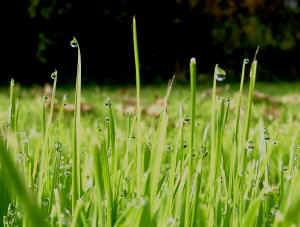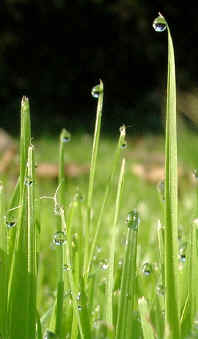Gutation
 |
Above: Gutation on grass, photographed soon after sunrise. Most people who get out of bed, pull back the curtains and look out of the window to see what the weather is like will have seen what they think is dew on the grass of their lawn, knowing that dew is often formed overnight. Dew forms on objects that get cold and water vapour in the air condenses out onto them. However what looks like 'dew drops' on the blades of grass above is not dew but droplets of water formed by a process called gutation. Gutation is the process that many plants use to expel liquid water from within when the water pressure inside the plant gets too high. This often happens overnight when transpiration is reduced to a minimum. (Transpiration is the process by which plants lose water vapour mostly during the daytime, helping them to control their temperature.) Only certain structures within the leaves of plants will allow liquid water to emerge (gutation) and these structures are different to those which allow transpiration to occur. Gutation is driven by excess water pressure from the roots of plants and often occurs when the soil around them is very wet, or when atmospheric humidity is high and effective transpiration (loss of water vapour) is not possible. This can sometimes happen overnight after a period of rain when the skies clear and the temperature drops.
|
Copyright © Offwell Woodland & Wildlife Trust 1998-2009 http://www.offwell.info
All the information including images, charts, movies and sounds is provided copyright free, only for educational use by schools, colleges and universities unless you are making a charge. If you wish to use information or any part of this site for commercial purposes or for any purpose where a charge is made then you must get permission, so make sure you contact us first. Remember, if you are not a school, college or university you must obtain permission to use any part of this website. Note that company logos are reproduced with permission and remain copyright of their respective owners.
